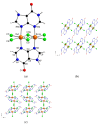Detection of Hypoxanthine from Inosine and Unusual Hydrolysis of Immunosuppressive Drug Azathioprine through the Formation of a Diruthenium(III) System
- PMID: 33440852
- PMCID: PMC7827764
- DOI: 10.3390/bios11010019
Detection of Hypoxanthine from Inosine and Unusual Hydrolysis of Immunosuppressive Drug Azathioprine through the Formation of a Diruthenium(III) System
Abstract
Hypoxanthine (hpx) is an important molecule for both biochemistry research and biomedical applications. It is involved in several biological processes associated to energy and purine metabolism and has been proposed as a biomarker for a variety of disease states. Consequently, the discovery and development of systems suitable for the detection of hypoxanthine is pretty appealing in this research field. Thus, we have obtained a stable diruthenium (III) compound in its dehydrated and hydrated forms with formula [{Ru(µ-Cl)(µ-hpx)}2Cl4] (1a) and [{Ru(µ-Cl)(µ-hpx)}2Cl4]·2H2O (1b), respectively. This purine-based diruthenium(III) system was prepared from two very different starting materials, namely, inosine and azathioprine, the latter being an immunosuppressive drug. Remarkably, it was observed that an unusual azathioprine hydrolysis occurs in the presence of ruthenium, thus generating hypoxanthine instead of the expected 6-mercaptopurine antimetabolite, so that the hpx molecule is linked to two ruthenium(III) ions. 1a and 1b were characterized through IR, SEM, powder and single-crystal X-ray Diffraction and Cyclic Voltammetry (CV). The electrochemical studies allowed us to detect the hpx molecule when coordinated to ruthenium in the reported compound. The grade of sensitivity, repeatability and stability reached by this diruthenium system make it potentially useful and could provide a first step to develop new sensor devices suitable to detect hypoxanthine.
Keywords: 6-mercaptopurine; azathioprine; biomarker; hypoxanthine; inosine; ruthenium.
Conflict of interest statement
The authors declare no conflict of interest.
Figures





Similar articles
-
A novel adenine-based diruthenium(III) complex: Synthesis, crystal structure, electrochemical properties and evaluation of the anticancer activity.J Inorg Biochem. 2022 Jul;232:111812. doi: 10.1016/j.jinorgbio.2022.111812. Epub 2022 Apr 6. J Inorg Biochem. 2022. PMID: 35421769
-
Addition of e-aq and H atoms to hypoxanthine and inosine and the reactions of alpha-hydroxyalkyl radicals with purines. A pulse radiolysis and product analysis study.Int J Radiat Biol. 1994 Oct;66(4):351-65. doi: 10.1080/09553009414551291. Int J Radiat Biol. 1994. PMID: 7930837
-
Purine nucleoside phosphorylase. Inosine hydrolysis, tight binding of the hypoxanthine intermediate, and third-the-sites reactivity.Biochemistry. 1992 Jul 7;31(26):5964-73. doi: 10.1021/bi00141a003. Biochemistry. 1992. PMID: 1627539
-
On the accessibility to conical intersections in purines: hypoxanthine and its singly protonated and deprotonated forms.J Am Chem Soc. 2012 May 9;134(18):7820-9. doi: 10.1021/ja300546x. Epub 2012 Apr 24. J Am Chem Soc. 2012. PMID: 22486543
-
Inosine and hypoxanthine as novel biomarkers for cardiac ischemia: from bench to point-of-care.Exp Biol Med (Maywood). 2015 Jun;240(6):821-31. doi: 10.1177/1535370215584931. Epub 2015 May 8. Exp Biol Med (Maywood). 2015. PMID: 25956679 Free PMC article. Review.
Cited by
-
Antiviral Potential of Azathioprine and Its Derivative 6- Mercaptopurine: A Narrative Literature Review.Pharmaceuticals (Basel). 2024 Jan 30;17(2):174. doi: 10.3390/ph17020174. Pharmaceuticals (Basel). 2024. PMID: 38399389 Free PMC article. Review.
-
A Gadolinium(III) Complex Based on the Thymine Nucleobase with Properties Suitable for Magnetic Resonance Imaging.Int J Mol Sci. 2021 Apr 27;22(9):4586. doi: 10.3390/ijms22094586. Int J Mol Sci. 2021. PMID: 33925589 Free PMC article.
References
-
- Chouraki V., Preis S.R., Yang Q., Beiser A., Li S., Larson M.G., Weinstein G., Wang T.J., Gerszten R.E., Vasan R.S., et al. Association of amine biomarkers with incident dementia and Alzheimer’s disease in the Framingham Study. Alzheimer’s Dement. 2017;13:1327–1336. doi: 10.1016/j.jalz.2017.04.009. - DOI - PMC - PubMed
-
- Lazzarino G., Amorini A.M., Petzold A., Gasperini C., Ruggieri S., Quartuccio M.E., Lazzarino G., Di Stasio E., Tavazzi B. Serum Compounds of Energy Metabolism Impairment Are Related to Disability, Disease Course and Neuroimaging in Multiple Sclerosis. Mol. Neurobiol. 2017;54:7520–7533. doi: 10.1007/s12035-016-0257-9. - DOI - PubMed
MeSH terms
Substances
Grants and funding
LinkOut - more resources
Full Text Sources
Other Literature Sources
Miscellaneous

